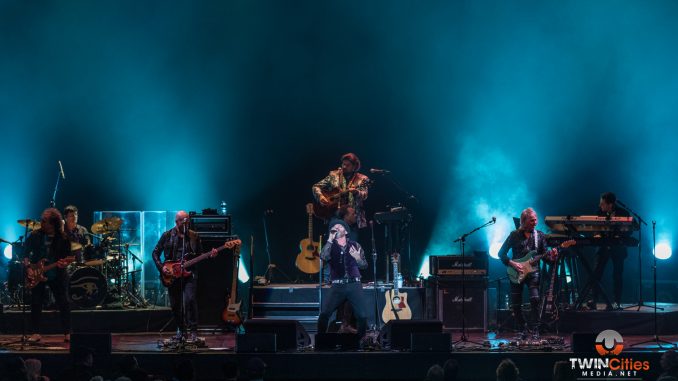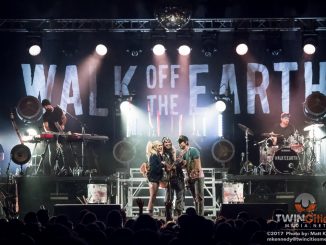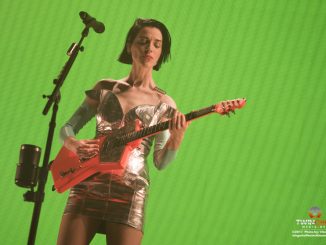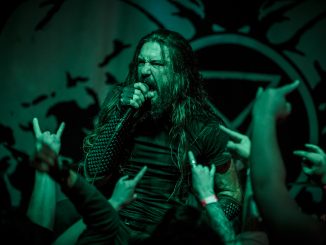
The temperature was quickly dropping through the teens as I made my way down a crowded Hennepin Avenue. I felt a bit of trepidation as I walked into the State. This was my second foray into a proscenium theater in the span of a week. That’s a rarity. Normally, club venues are more to my liking. There, that lovely energy loop between audience and performer is easier to achieve and maintain.
Also, this particular show had all the hallmarks of a potential Dad Rock show. You know the kind I mean. Where a once king or queen of the stage is milking past glories with a bunch of unknown musicians. Where the wrinkles, burgeoning belt lines and iconic poses really strain our imagination to make it work. So it was with a bit of that mixture of anticipation and trepidation that I made my way down to my seat.
I had a few moments to make the acquaintance of two neighbors prior to the start. There was Lanette, who hadn’t been downtown in 15 years. A friendship with vocalist PJ Olsson brought her out. Locked and ready to roll. She’d roped in her cousin Pat, who averred she hadn’t been to a concert since she couldn’t remember when. She admitted her husband still took in the occasional show. But then Pat announced she had finally agreed to go see Leo Kotke at The Guthrie later in the month (at his insistence). When she asked if I was going to that show, I answered in the affirmative and we found common ground.
House lights dimmed, warmers came up and the deep bass notes from May Be A Price To Pay emanated from the sound system. The band bounced onto the stage and a cheer went up. When Alan Parsons walked out, clad in a suit coat Little Richard would have envied, the crowd stood as one and thundered an ovation.
His was an 8 piece band, set with five players across the front. Dan Tracey on guitar, Guy Eraz on bass, Olsson with his acoustic and voice, Jeff Kollman with his Marshall stack and sexy sea-foam green Strat and multi-instrumentalist Todd Cooper. In the line behind were drummer Danny Thompson and keyboard/synth wizard Tom Brooks. Like Zeus himself, Parson mounted a riser sitting high above the floorboards in the center back. It was like his own personal Mt Olympus. He picked up his acoustic guitar and gazed upon his subjects before him. The band opened with Standing On Higher Ground.
Concern number one was immediately eliminated. This was also a bit of theater. The light show sublime. It wanted that proscenium arch. The band was in the proper venue. It didn’t take long to get comfortable with how the audience would behave, either. This bunch was made up of hardcore APPL fans. They weren’t going to be passive.
The audience quickly picked up the invitation to rhythmically clap as the band shifted into Don’t Answer Me. Lead vocals were handled by the aforementioned PJ Olsson, as they would be for a majority of the songs. During the chorus, all eight members stepped to the microphone and sang like angels. Waves of harmony rolled through the State. Eat your heart out Beach Boys! So much of Alan Parson’s music is built around beautiful vocals. Tonight he had all the tools he needed to make them shine. Cooper put a cap on it with a searing tenor sax solo before moving to center stage to take over the lead singing duties for Psychobabble.
Gorgeous sonic waves evoking Pink Floyd washed over me as the band downshifted into Time. No great surprise here, given that a young Parsons sat at the sound board as the groundbreaking Dark Side of the Moon was laid down. I found myself transported to an earlier time, wondering how many college bong sessions had concluded with this spaced out piece of Prog rock. The crowd was fully engaged. Howling at Kollman’s timeless guitar solo.
Parsons gazed down at his band, arms spread wide, and saw that it was good. This was how the show would be structured. Zeus from his mountain top, staying out of the limelight for the most part. Letting his crackerjack band work. The rhythm section of Thompson and Erez was simply magnificent. Together, they provided the huge foundation required to build the many-spired castle which is this band.
I found myself wondering why the genre we call Prog Rock effectively passed away. For years, it was a staple of the FM airwaves. Alan Parsons was as big as any of the purveyors of that trippy, rock style. Prog was a British convention. Pink Floyd, Yes, Peter Gabriel’s Genesis along with bands like Emerson, Lake and Palmer. The arrangements were challenging. The musicianship world class. Songs were written to break ground; to not adhere to any formerly accepted rules. This was music from when albums were king. Flow and construction was viewed as an art form in itself. More on that thought, in a minute.
To my mind, much of this disappearance came as America began to change. A deep recession stripped us of bigger dreams. Disco and Urban Cowboys became our cultural touchstone. Punk music crossed the pond to our shores. In the process music was socialized and handed willy-nilly to the rabble.
It’s ironic that while Americans invented blues and its baby rock n’ roll, it was the Brits that picked these up and imbued them with their own Anglo flare. It was a musical invasion. It seemed more sophisticated, more royal, more refined. For many, however, it also became seen as pretentious. Particularly to those who could never dream of doing it. I’ll admit to buying into much of this during my formative years. We had a penchant for smirking; disparaging those more casual music fans with their less sophisticated tastes. Eventually, the tides of pop culture drown us, smirks still frozen on our faces.
Then again, as I prefer to believe and experienced last night, this music WAS more sophisticated, more royal and more refined! But it was absorbed by an industry which was laser focused on profits. A world that stripped away the ornate and baroque in favor of the pedestrian, utilitarian, repeatable…and disposable.
In fact, didn’t Parsons himself allude to that when he taught the audience the chorus to Breakdown? He mused: “On the album we had a wonderful group of girls to sing this part. We have no girls on our stage here tonight. Budget cuts and all, you know?” When we finished singing: ‘Freedom! Freedom! We will not obey. Freedom! Freedom! Take the wall away.’ Alan laughed and said: “Now imagine getting paid for doing that!”
In the back half of Part 1 of the show Parsons dedicated the song Limelight to his old partner Eric Woolfson, who passed from cancer back in 2009. According to Parsons, he was a man who never got his due. Simply because the band was called the Alan Parsons Project as opposed to something like The Woolfson Parsons Project. He asked the audience to take out cell phones, turn on the flashlights and to wave them during a specific part of the chorus. He wondered if perhaps this was what he friend had always wanted and never received. The moment was spectacular. Who needs house lights? The State glowed.
An hour in, the audience was probably beginning to wonder if this would be a two set show. Or would we turn and head for home? Even if the band was in the homestretch, it would have been a wonderful evening. But the night was just beginning. Parsons announced that the album I, Robot had turned 40 in the past year. So they had decided to play the entire thing straight through. If it was possible, the energy in the house ratcheted up another couple notches. This was the album that put the band on the map. It was the entry point for most of us in the crowd.
The band tore through the album note for note. I was in awe that an 8 piece band was able to replicate the recordings with this degree of accuracy. Usually, I’m not a fan of simply delivering the original arrangement. Times change. Songs evolve and bits of improvisation add life. Not here. Quite frankly, each of these songs was a complete, detailed masterpiece when it was laid down. Changing anything would constitute a blasphemy. As I wrapped my mind around this seeming perfection, I flashed back to a conversation I had with a friend years ago at Roger Water’s redux of Dark Side of the Moon. A young Doyle Bramhall II laid down lead lines which channeled David Gilmour to perfection. Because it was Dark Side of the Moon, it had to be done that way. Because it was I, Robot, it had to be done that way.
As Don’t Let It Show wrapped up, the band took a moment to reload. Parsons announced we had come to the end of Side 1. And now for Side 2. As a guy who came to the industry (and remains) a studio wizard, he had a strong opinion to state. He reminded us of a time when our albums were all vinyl. When one side came to an end, you had to get up, walk across the room and turn it over. How people took a moment to grab a cup of tea or roll one of those special cigarettes before dropping the stylus back into the grooves. How the act of listening was an engaged commitment. Most of us chuckled. Only our age kept a cloud of sweet smelling smoke from instantly wafting into the auditorium. Many of us would have welcomed it.
But I think he also made the point that we have lost so much in the way we listen to music these days. MP3’s and Spotify contain something like 1/13th of the actual musical signal. They rely on our brain’s uncanny ability to fill in gaps. The problem is we don’t always fill those gaps accurately. Ask any cop about what happens when there are multiple eye witnesses to a crime. Compound that problem with tiny earbuds that cannot move air. The likes of Pink Floyd and Alan Parsons Project Live suffer greatly in that format. Bless Mr Parsons for refusing to give in to practicality and mediocrity. This is music intended to be listened to through an un-compromised sound system. Stuffed full of sonic Easter eggs.
Last night I, Robot stood the test of time. Every track remained as vibrant as when I first heard them back in my final year of college. The audience agreed. Singing passionately, howling at the solos and leaping to their collective feet, time and time again. Album complete, the main set concluded with Sirius and Eye In The Sky, from the album titled after the latter. Some songs are so deeply embedded in our culture that everyone knows them, even if they have no idea when they were done or who did them. The ovations for both seemed to go on forever.
The band returned to the stage for two. The Poe adaptation The System of Dr Tarr and Professor Fether was celebratory. It seemed to accurately reflect the mood of the rapt, standing crowd. The show closed with the FM staple Games People Play. I knew that one was coming. My first reaction was to cringe. After all, even the greatest songs reach a point where they are played so often that you are tempted to go spinning the radio dial when it comes on for the millionth time. Boy, was I wrong again. From the stage, the song was huge. It sparkled. The love that flowed toward the stage became a torrent.
The houselights came up and we gathered our coats. I listened to people around me, delighted and exultant. They’d gotten what they’d come for and more. Turning to my neighbors Pat and Lanette once again, I asked if the night had convinced them how great live music was? How much fun a downtown weekend night in Minneapolis can be, no matter how cold? I think it’s safe to say that Lanette will be back at a show before long. And that next time Pat’s husband invites her to a show, she won’t think twice. The late Sue McLean used to tell us live music was good for our souls. When it’s as breathtaking as The Alan Parsons Project Live, it’s an escalator straight up Mt Olympus.




I agree with the review in terms of the feel, the music, and musicianship. Unfortunately the sound quality at the State was terrible. Being a longtime fan, Alan Parsons has always been noted for pristine sound, forward vocal mixes. Fridays mix was brown and the vocals were often buried. The vocals were mixed well as a group, but were never up front when solo or duo – only when 6 or 7 as a group. On 2 occasions PJ sounded as if he were singing through a harmonizer where only he heard the effected output – over a note sharp for an entire passage. I noticed Jeff Kollman raising he guitar a couple times as if to get the FOH attention that he was going into a solo – made me wonder if the mix engineer was a rental for the night. We had decent seats, near center, front row of Loge section, so it wasn’t a room reflection problem – mre of a mushy FOH mix. Despite that, the musicianship was impeccable, parts played were flawless, vocal harmony terrific. Great music, great band.